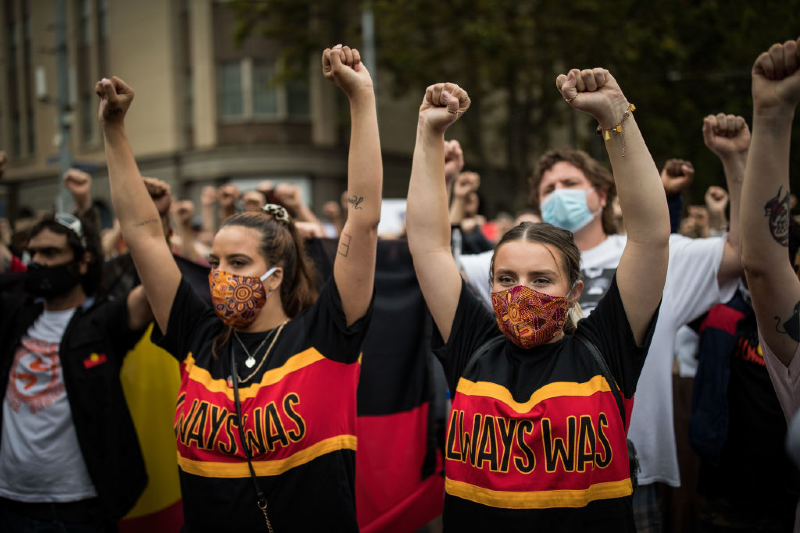It’s a tradition of mine to undertake my own “media watch” experiment following the annual Invasion Day rallies. For absolute decades it has been noted that the continual negative reporting of Aboriginal and Torres Strait Islander people, our fights and our political movements, fuel negative public perceptions of us leading to racism and bullying, as well as lower self-esteem and mental health outcomes in our own communities.

Certainly, Invasion Day reporting has followed this trend. As noted in some of my previous work, media have not only consistently underreported the numbers attending the Invasion Day rally therefore diminishing what is a large and growing movement, they have also repeatedly highlighted the apparent threat of violence while noting the large police presence at the rallies, allegedly to “control” these threats.
One year a media outlet stated that there were 150 participants at the rally when the numbers were closer to five thousand. Not a single rally I have been to has been anything but peaceful and the only exception to this has been incidents where police have failed to intercept extreme right actors (now noted to be taking up 40 per cent ASIO’s anti-terrorism resources) who’ve entered rallies to cause havoc. Each time this has happened, marshals and/or participants have moved swiftly to contain these aggressors.
Then there are the truly ridiculous and racist extremes — talking heads who continuously state rally participants don’t care about the “real issues” in Aboriginal communities such as violence, alcohol and drug dependency and unemployment. They proceed to talk with unearned authority about “remote areas”, which despite them claiming participants don’t care, they themselves only ever talk about people who live in these areas in theoretical and ethereal ways. It’s been of constant amusement (in that gallows humour sense) that they additionally appear to know nothing of the rally organisers across the country and the fact that these staunch people also tend to work in the very areas these media “pundits” claim rally participants are not interested in.
Anyway, the point is that I have seen it all and when I looked at this year’s reporting, I was expecting more of the same. I ended up being pleasantly surprised. Taking Melbourne’s reporting as a starting point, most reports featured details of the lengths the rally went to around COVID restrictions and safety precautions. Many featured interviews with speakers and rally participants talking about why they were there, and most were factual when it came to the purpose of the rally — this was not a rally to “change the date” of Australia Day as organisers have been trying to highlight for years, this was a rally about highlighting the continued impacts of colonisation while calling for change and justice.
Interstate, reports followed similar trends. The Perth rally was reported as being the largest ever, as was the Adelaide rally. The Brisbane rally and subsequent gathering at Musgrave was also covered as such while also stating that masks were being worn by a lot despite the lack of cases in the city. Sydney coverage was a bit different. While it covered arrests at the Domain, it also covered a largely peaceful gathering generally speaking with police praising attendees. ABC News Alice Springs published photos of a gathering of 300 on the courthouse lawns. It was a pleasure to see family members within these pics.
'I just hope to see a continued commitment to accurate and respectful reporting when it comes to Indigenous issues.'
Perhaps the biggest shock was a Channel 7 report that happened prior to the rally in Melbourne. For the unaware, marshal training happens annually to ensure the crowd moves safely and cohesively through the city. So it was strange that this year, Channel 7 arrived at the marshal training to cover it. Though their report did revert to the wrongful messaging regarding the rally being to change the date, the coverage focussed positively on the commitment to a COVID safe event in Melbourne and juxtaposed the Freedom Day rally organised by anti-maskers and Proud Boys that was also organised for the 26/1. It was a relief to see Invasion Day framed as being an organised and responsible event taking measures to protect the public while right wing protests were, for once, framed (accurately) as violent and irresponsible.
Given all this, do I think we’re finally witnessing a change in attitude by the media when it comes to Invasion Day and the annual marches we hold for our rights? To a degree, yes. That being said, I do wonder if this change in coverage will continue or whether we’ve just had a lucky year. Certainly, the numbers keep growing at Invasion Day rallies and the media pretending that these are small, violent and ignorant gatherings couldn’t continue, particularly given we’re in the midst of a pandemic and still people want to march and do everything they can to ensure the public are kept safe while they do so. Perhaps the complete lack of community transmission of COVID at the earlier Black Lives Matter rally, despite media trying to claim otherwise at the time, pushed media to take a different tact? I just hope to see a continued commitment to accurate and respectful reporting when it comes to Indigenous issues.
What I don’t believe is that this indicates a massive shift in public perceptions when it comes to Indigenous people. There is so much more work to be done. The public needs to question the exorbitant rates of incarceration of Indigenous people. It needs to question why so much of the history we’re taught is whitewashed. It needs to start activating and pushing for a fairer and more inclusive future. It needs to push for treaties, for example, which agree to protect the rights of Indigenous people while carving out ways the country can move forward which aren’t continuously about the erasure and assimilation preferred by successive governments for generations. The calls made at Invasion Day — regarding Indigenous lands, justice, acknowledgement and respect — must be answered. 83 years of Indigenous people having to march on this day indicates the issues remain. It’s time that changed.
px.jpg)
 Celeste Liddle is a trade unionist, a freelance opinion writer and social commentator. She blogs at Rantings of an Aboriginal Feminist.
Celeste Liddle is a trade unionist, a freelance opinion writer and social commentator. She blogs at Rantings of an Aboriginal Feminist.
Main image: Main image: Invasion Day protestors Melbourne (Darrian Traynor/Getty Images)